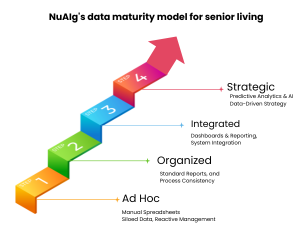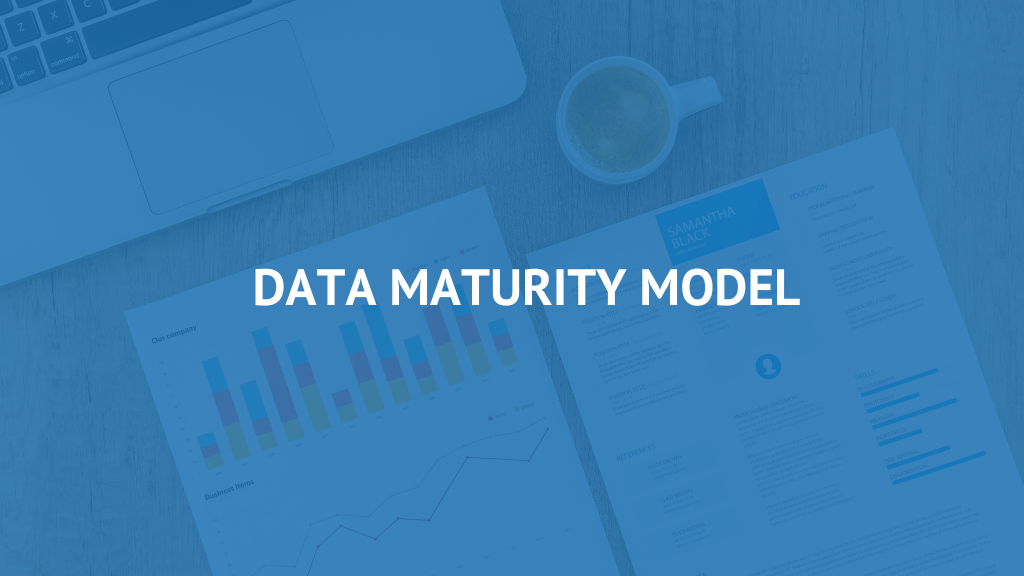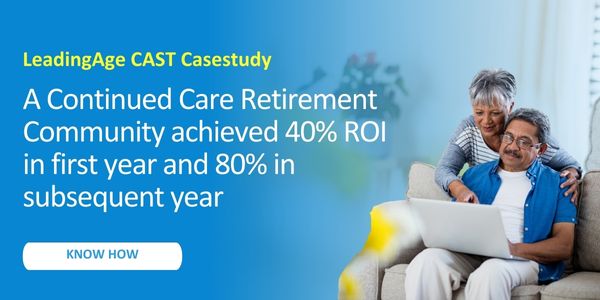NuAIg’s Data Maturity Model for Senior Care Providers
Data is the most rapidly growing resource on the planet — we generate 2.5 quintillion bytes every day. Even more astounding: 90% of the world’s data has been generated in just the past 5–7 years.
But what’s really changed isn’t just the amount of data — it’s how we use it. That’s where data maturity enters the conversation.
What Is Data Maturity?
Data maturity is the journey from “I have information, but don’t know what to do with it” to “I can use my data to make smarter, faster decisions.”
In the world of aging services, data maturity is how a senior care provider evolves from “just surviving” to “smart, caring, and strategic” — simply by using their information better over time.
Think of it as a measurement system for how well your organization uses data. A data maturity model helps you:
- Assess your current data practices
- Compare yourself to industry benchmarks
- Identify areas for improvement
- Create a roadmap to smarter operations
Why Does Data Maturity Matter?
You could wait for data maturity to “naturally evolve” in your organization — but that’s a gamble. Without a clear strategy, growth is slow, inconsistent, and often expensive.
By contrast, having a customized data maturity model streamlines the evolution of your systems and empowers you to act on insights faster.
Data maturity is crucial in senior living as it enables communities to make informed, data-driven decisions that enhance resident care, operational efficiency, and financial performance. A mature data model ensures that data is accurate, accessible, and actionable across departments.
Use Case 1: Fall Risk Management in Assisted Living
By aggregating data from EHRs, incident reports, and wearable devices, mature data systems help staff proactively identify residents at risk of falling. Timely interventions reduce falls, enhance resident safety, and lower healthcare and liability costs.
Use Case 2: Optimizing Staffing Costs
A data-mature community can analyze occupancy trends, resident acuity levels, and staffing patterns to align staffing levels with real-time needs. This prevents overstaffing during low-demand periods and understaffing during peak times, reducing unnecessary labor costs while maintaining quality care.
These use cases demonstrate how data maturity drives both better care and improved financial outcomes, supporting long-term sustainability in senior living operations.
Senior Living Pain Points — and How a Data Strategy Helps
| Pain points (Before Data strategy) | Solution (Implementing Data Strategy) |
| Disconnected System | Unified Data Platform |
| Limited Insights | Real-Time Dashboards |
| Manual Reporting | Automated Compliance Tools |
| Reactive Care | Predictive Resident Analytics |
| Staff Burnout | Workforce Optimization Models |
Result: Smarter decisions. Better care. Stronger financial performance. Empowered teams.
NuAIg’s Insights – 4 Levels of Data Maturity in Senior Living
We’ve worked closely with long-term care providers to develop a model tailored for your industry. Where does your community currently stand?
Level 1: Ad Hoc
Siloed data, spreadsheets, and manual reports.
Level 2: Organized
Basic systems in place with standard reporting.
Level 3: Integrated
Centralized, unified data with real-time dashboards.
Level 4: Strategic
Predictive analytics, proactive decision-making, optimized outcomes.

Once you identify your current level, you can fast-track your data journey with a strategy that aligns to your short- and long-term goals.
Related
Blog – AI-Powered Talking Dashboards: Transforming Fall Prevention in Elderly Healthcare
NuAIg’s Strategic Workflow
Our framework is designed specifically for senior care providers:
1. Understanding Your Software Ecosystem
We’ve built a deep knowledge base of the software, systems, and integrations used across the aging services industry.
2. Opportunity Mapping
We’ll identify current gaps and guide your stakeholders through a vision for better processes and smarter systems.
3. Customized Transformation Roadmap
We’ll design a strategy tailored to your goals, helping you evolve from reactive to proactive care.
4. Sustained Support
As technology changes, so do we — continually advising you on ways to future-proof your data infrastructure.
Ready to Elevate Your Data Strategy?
Let’s find out how data maturity can help your community deliver better care, reduce staff burnout, and make faster, smarter decisions.
Visit www.nuaig.ai
Or reach out to us at info@nuaig.ai
Your first strategy consultation is on us!





